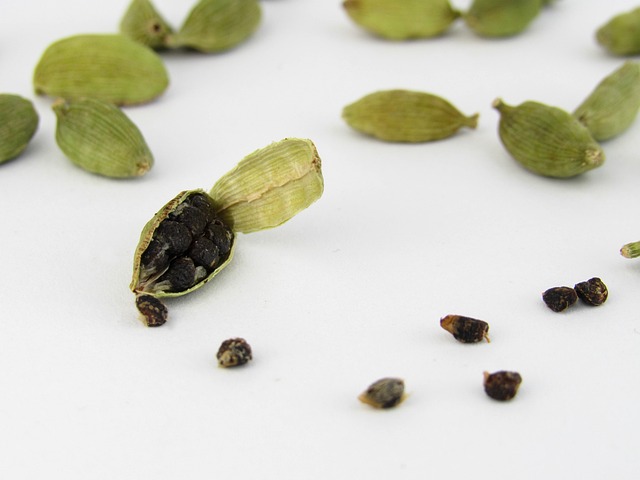Cardamom, often called the “,” has played a major role in both global cuisines and traditional medicine for centuries. With its sweet, spicy, and floral flavor, cardamom enriches a wide range of dishes. It is also used for its health benefits. This article explores the origins, culinary applications, and historical significance of this powerful spice.
What is Cardamom?
Cardamom comes from the seeds of the Elettaria cardamomum plant, a member of the ginger family. There are two main types of cardamom:
- Green cardamom: Known for its sweet, floral flavor, green cardamom is widely used in sweet and savory recipes.
- Black cardamom: This variety offers a smoky, earthy taste, making it a common ingredient in savory dishes.
Cardamom grows in tropical climates, particularly in India, Sri Lanka, and Guatemala. These regions provide the warm, humid environment needed for the cardamom plant to thrive. Today, Guatemala produces the most cardamom in the world, even though the spice has its origins in India.
Origin and History of Cardamom

Ancient Uses of Cardamom
Cardamom has a rich history that goes back thousands of years. In ancient India, practitioners of Ayurvedic medicine relied on cardamom to treat digestive issues and respiratory problems. The spice also played a role in balancing the body’s doshas (energy systems), according to Ayurvedic teachings.
- Ayurvedic Medicine: Practitioners used cardamom for treating bloating, indigestion, and coughs. They believed the spice promoted overall health by improving digestion and calming respiratory issues.
- Spiritual and Religious Use: People in ancient India often used cardamom in religious rituals, considering it a sacred spice.
By 1500 BCE, cardamom had spread beyond India. Traders transported it along ancient trade routes to the Middle East and Europe, where it quickly gained popularity. The spice became a symbol of luxury due to its exotic flavor and healing properties.
Global Spread of Cardamom
By the time of the Roman Empire, cardamom had already established itself as a luxury spice in Rome and Greece. Wealthy Romans used cardamom in perfumes and medicines, while Roman physicians prescribed it for digestive problems and bad breath.
Cardamom traveled further along the Silk Road, reaching regions in North Africa and Europe. Its journey helped it become a key ingredient in many different cuisines. People in the Middle East, Africa, and Europe started using cardamom for its unique flavor and medicinal benefits
Culinary Uses of Cardamom
Cardamom’s flavor works well in both sweet and savory dishes, making it a versatile spice. Its unique taste enhances a wide variety of recipes, from spiced teas to rich curries and baked goods. This versatility explains its global popularity.
Common Dishes Using Cardamom
Indian cuisine relies heavily on cardamom. The spice is often used in kheer (a sweet rice pudding) and chai (spiced tea), adding warmth and complexity to both dishes. Cardamom also enriches the flavors of curries, biryanis, and rice dishes.
In the Middle East, cardamom plays a crucial role in making Arabic coffee. Coffee beans are brewed with cardamom, creating a fragrant and flavorful beverage. The spice also enhances desserts like baklava, a rich pastry layered with honey.
Scandinavian cuisine uses cardamom in baked goods. Cardamom buns and other pastries get their warm, spicy flavor from this versatile spice. It pairs well with cinnamon, another common spice in Scandinavian desserts.
- Indian Dishes: Popular in kheer (rice pudding) and halwa (sweet dishes), as well as in curries.
- Middle Eastern Coffee: Ground cardamom is brewed with coffee beans to create a fragrant drink.
- Scandinavian Pastries: Cardamom adds warmth and spice to buns and cakes.
Flavor Profile of Cardamom
Cardamom’s flavor is both sweet and spicy, with hints of citrus and floral notes. This unique combination makes it a perfect match for other spices like cinnamon, cloves, and ginger. The spice adds depth to savory dishes and balances sweetness in desserts.
For savory dishes, cardamom complements rich meats such as lamb and beef. In desserts, cardamom enhances the flavors of fruits like apples, pears, and oranges. Its warm, complex taste works well in a wide range of dishes.
- Spice Pairings: Combines well with cinnamon, nutmeg, cloves, and ginger.
- Ingredient Pairings: Works beautifully with lamb, root vegetables, and fruits like pears.
Substitutes for Cardamom
Although cardamom has a distinctive flavor, there are substitutes that can work in many recipes. A mix of cinnamon, nutmeg, and cloves can replace cardamom’s warmth and spice. Coriander and clove also make a good substitute in savory dishes.
For desserts, cinnamon can replace cardamom’s sweet, warm flavor. In savory recipes, a combination of cloves and coriander mimics cardamom’s complex taste. While these alternatives work in most cases, they can’t fully replicate the unique floral and citrusy notes of cardamom.
- Clove + Coriander: Suitable for savory dishes, especially for spiced meats..
- Cinnamon + Nutmeg: A common replacement in sweet recipes.
Health Benefits of Cardamom

Cardamom contains powerful compounds that contribute to its health-promoting effects. This spice can improve digestion, reduce inflammation, and support heart health, among other benefits.
Rich in Antioxidants
Cardamom is packed with antioxidants that help protect the body from damage caused by free radicals. Free radicals are harmful molecules that can damage cells and contribute to the development of chronic diseases like cancer and heart disease. Antioxidants neutralize these harmful molecules, promoting overall health.
- Protects Cells: The antioxidants in cardamom help protect cells from oxidative stress, which may reduce the risk of long-term health issues.
- Promotes Healthy Aging: Regular consumption of antioxidant-rich foods like cardamom may slow down the aging process by protecting cells from damage.
Improves Digestive Health
One of cardamom’s most well-known benefits is its ability to improve digestion. This spice has been used for centuries to treat indigestion, nausea, and bloating. It stimulates the production of digestive enzymes, which helps break down food more efficiently.
- Soothes Indigestion: Cardamom can relieve discomfort caused by indigestion, such as bloating and gas.
- Reduces Nausea: Its soothing properties make it effective in reducing nausea, making it useful for people experiencing motion sickness or pregnancy-related nausea.
- Encourages Healthy Digestion: By promoting the production of digestive enzymes, cardamom supports the digestive system and enhances nutrient absorption.
Anti-Inflammatory Properties
Cardamom contains compounds that have anti-inflammatory effects, which can help reduce inflammation throughout the body. Chronic inflammation is linked to various health problems, including arthritis, heart disease, and diabetes.
- Reduces Inflammation: Cardamom’s anti-inflammatory properties may help alleviate symptoms of inflammatory conditions, such as joint pain.
- Supports Heart Health: By reducing inflammation, cardamom can also support a healthy cardiovascular system and lower the risk of heart disease.
Supports Heart Health
Cardamom has been shown to help regulate blood pressure and improve overall heart health. It contains compounds that act as natural diuretics, helping the body eliminate excess fluid and reducing pressure on the heart.
- Lowers Blood Pressure: Studies have found that cardamom may help lower blood pressure in people with hypertension by promoting the elimination of excess fluid.
- Improves Circulation: Cardamom promotes healthy blood flow and improves circulation, which can reduce the risk of heart-related conditions.
Active Components in Cardamom and Their Benefits
1. Cineole
- Description: Cineole is a powerful essential oil present in cardamom, known for its antimicrobial and anti-inflammatory properties.
- Health Benefit: Cineole helps improve blood circulation, which may benefit sexual health by ensuring proper blood flow to the genital areas. Improved circulation can help in reducing issues like premature ejaculation in men by promoting better erectile function and overall endurance.
2. Terpenes (Limonene, Linalool, and Sabinene)
- Description: These aromatic compounds contribute to cardamom’s distinct fragrance and offer anti-inflammatory, antioxidant, and mood-enhancing properties.
- Health Benefit: Terpenes, particularly limonene, help reduce anxiety and stress levels. Studies suggest that reducing stress can improve male sexual performance, potentially delaying ejaculation and improving sexual stamina. In females, reduced anxiety can enhance libido and increase arousal, supporting overall sexual well-being.
3. Eugenol
- Description: Eugenol is another essential oil in cardamom that has antioxidant and anti-inflammatory effects.
- Health Benefit: Eugenol helps regulate hormones by balancing oxidative stress. In males, oxidative stress can contribute to issues like premature ejaculation or erectile dysfunction. Eugenol’s hormone-regulating effect may help reduce these problems. In females, it supports balanced hormone levels, which can lead to improved sexual desire and function.
4. Zinc
- Description: Cardamom is a source of zinc, an essential mineral for sexual health.
- Health Benefit: Zinc plays a significant role in testosterone production, which directly impacts male sexual health. Adequate zinc levels improve sperm quality, enhance libido, and may help address issues like premature ejaculation. For females, zinc supports fertility and reproductive health by regulating hormones and improving sexual desire.
Cardamom Benefits for Men and Women
| for Men | for Women |
|---|---|
| Boosts blood flow, enhancing erectile function and stamina. | Balances hormones, boosting libido and overall sexual health. |
| Reduces anxiety, helping manage premature ejaculation. | Lowers anxiety and stress, enhancing sexual desire and satisfaction. |
| Supports testosterone production, boosting libido and sperm health. | Improves blood circulation, enhancing arousal and sensitivity. |
How to Use and Store Cardamom in Your Kitchen
To fully enjoy the benefits of cardamom, it’s important to know how to use and store it properly. Fresh cardamom retains its flavor and potency much longer than pre-ground cardamom.
Proper Storage for Maximum Freshness
Cardamom can lose its flavor quickly if not stored correctly. To maintain its freshness and potency, store cardamom in an airtight container and keep it in a cool, dark place. Whole cardamom pods will stay fresh for much longer than ground cardamom.
- Store in Airtight Containers: Keeping cardamom sealed in an airtight container will prevent exposure to air, which can cause it to lose its flavor.
- Avoid Heat and Sunlight: Storing cardamom away from direct heat and sunlight will help maintain its potency.
- Shelf Life: Whole cardamom pods can last for up to two years if stored properly, while ground cardamom should be used within six months for the best flavor.
Using Cardamom in Cooking
To maximize the flavor of cardamom in your dishes, it’s best to grind fresh cardamom pods just before using them. This will release the spice’s essential oils, providing a more intense flavor. Whether adding it to savory stews or sweet pastries, freshly ground cardamom makes a noticeable difference.
- Grind Fresh Pods: Grinding cardamom pods fresh ensures maximum flavor in your dishes.
- Balance in Sweet and Savory Dishes: Cardamom enhances both sweet and savory recipes, making it versatile in the kitchen.
- Adding to Beverages: Cardamom works well in hot drinks, such as tea or coffee, adding warmth and aroma to each cup.
Frequently Asked Questions About Cardamom
Here are some common questions about cardamom and its uses, based on what people often ask.
What is the difference between green and black cardamom?
Green cardamom has a sweet, floral flavor and is used in both sweet and savory dishes. Black cardamom, on the other hand, has a smoky, earthy taste and is typically used in savory recipes like stews and curries.
Can cardamom help with weight loss?
Cardamom may support weight loss by boosting digestion and metabolism. It encourages the breakdown of fat and helps the body eliminate waste, which can aid in weight management.
Is cardamom safe for pregnant women?
Cardamom is generally safe for pregnant women when used in food amounts. However, it’s always best to consult a healthcare provider before consuming large quantities or using it as a supplement during pregnancy.
What are the side effects of cardamom?
Cardamom is safe for most people when consumed in normal food amounts. However, some individuals may experience allergic reactions or gastrointestinal discomfort when consuming large amounts.
How long does cardamom last?
Whole cardamom pods can stay fresh for up to two years if stored properly. Ground cardamom should be used within six months for the best flavor and aroma.

